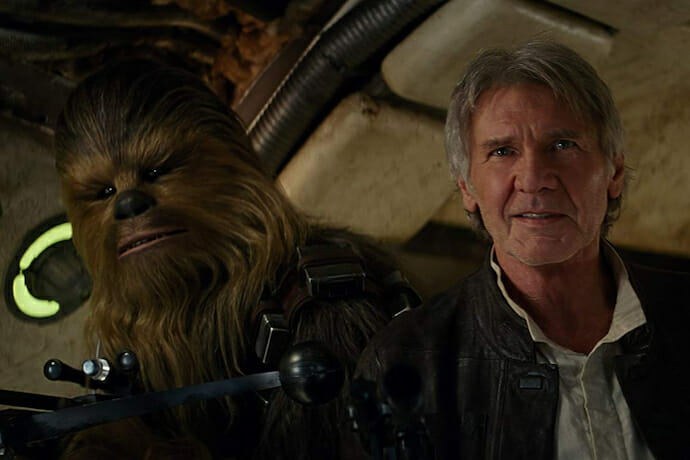
John Williams’ Star World
As anticipation turns to hysteria for composer John Williams’ new score for Star Wars: Episode VII, fans can rejoice in the hours of dulcet melodies already written. The middle Star Wars episodes, IV – VI, are best known musically; they established the Force theme, the Imperial March, and the Star Wars franchise theme.
But the first three episodes are full of fascinating fantasy, from war themes to romance to parade.
Star Wars Episode I: The Phantom Menace (1999), maligned by many for its addition of Jar Jar Binks to the cast of characters, nonetheless produced strong music.
“Working on this movie was like writing for an old friend,” John Williams says in an interview. “For me, it seemed to me like the experience I had twenty years ago, even though the characters were different. There was a family connection, a bond of family union for it all.”
The third cue on the 1999 Sony album, “Anakin’s Theme,” voices Anakin Skywalker, the eight-year-old boyhood identity of Darth Vader. John Williams calls the theme “the sweetest and most innocent thing you’ve ever heard.”
Indeed, Anakin’s music has a pastoral grace to it—almost like ballet. In its latter verses, it contains tiny echoes of the Imperial March. But mostly it meanders like a feather in the wind. Although composed nearly two decades after the release of episodes IV – VI, the music feels part of the same galaxy.
The signature battle music for The Phantom Menace, “Duel of the Fates,” brings new orchestral vocabulary into the franchise—the choir. The primal, insistent choral motif, composed of Sanskrit lyrics, dramatizes the long light saber duel with Darth Maul that concludes the film. It raises the stakes of the scene to galactic proportions. Critical for the listener, the chorus is on a completely different wavelength than the light saber sound effects.
“The Flag Parade” finds Williams at his brassy best. It lends ceremony and substance to idea that a noble Republic existed before the Empire.

Musically, the jewel of Star Wars Episode II: Attack of the Clones (2002) is the love theme for Anakin and Padmé, the first love theme for the franchise. Called “Across the Stars” on the Sony regular edition 2002 album, the theme equals in scope any of the classic themes from Episodes IV- VI. The long violin phrases, accented by harp, exude romance. It is easy to believe that this union has surpassing political consequences.
“It seems probably the last thing you would think of,” says John Williams of the theme, “but a love theme for a love story that has sort of cosmic reaches to it, if you like. It’s a — when we think about love stories, I think of you know Romeo and Juliet or Tristan Iseult (ph) or these kinds of things where the lovers are separated by rank or they’re separated by religion or family or class or whatever, and that’s the case here also.”
“Yoda and the Younglings” is a tender tribute to Yoda’s work training the children and future Jedi.
The final cue, “Confrontation with Count Dooku/Finale,” narrates the final scenes of the film. It’s a rich suite of expertly sequenced themes, beginning with the Force theme, the Imperial March, and the love theme. The love theme segues into the Star Wars theme as the credits roll. The fluid transitions are a marvel to hear.
Star Wars Episode III: Revenge of the Sith (2005), sees the rise of Darth Vader, as Anakin as a casualty of battle with Obi-Wan Kenobi. The score’s themes are appropriated malevolent. It is also the most chorus-based of all the franchise scores.
“General Grievous,” the theme for the cyborg villain, is rife with percussive mayhem.
“Palpatine’s Teachings” features hellishly low male choral notes, suggesting the base edification in Palpatine’s lyceum. This darkness is largely absent from the middle Star Wars trilogy.
Anxious Star Wars fans can also look to John Williams’ most recent score, The Book Thief (2013), for clues to the composer’s current muse. But the tone is galaxies away from Star Wars.
The Book Thief speaks to the cultural affliction wrought by Nazi Germany and Williams delivers a suitably thoughtful, lyrical score.
Williams is an odyssey-bound artist, having journeyed from the The Cowboys (1972) to The Towering Inferno (1974) to Jaws (1975) to Star Wars Episode IV: A New Hope (1977) to Harry Potter and the Sorcerer’s Stone (2001) to War Horse (2011) and beyond.
It’s possible that fans will never hear a Williams fanfare precisely in the style of the original Star Wars theme. They will likely hear something quintessentially Williams but novel, challenging, and mysterious. And that’s the mark of a true maestro—evolution.

